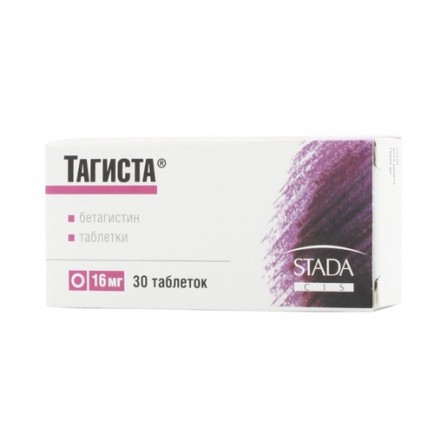More info
Active ingredients
Betahistine
Release form
Pills
Composition
1 tablet contains: Active substance: betahistine dihydrochloride 16 mg. Auxiliary substances: microcrystalline cellulose - 109.5 mg, povidone (collidon 25) - 18 mg, potato starch - 40 mg, citric acid - 4 mg, colloidal silicon dioxide (aerosil) - 6 mg, talc - 5.6 mg, magnesium stearate - 0.9 mg.
Pharmacological effect
A drug that improves the microcirculation of the maze, used in the pathology of the vestibular apparatus. Betahistin acts mainly on the histamine H1 and H3 receptors of the inner ear and the vestibular nuclei of the central nervous system. Through direct agonistic action on histamine H1 receptors of inner ear vessels, as well as indirectly through effects on histamine H3 receptors, improves microcirculation and capillary permeability, normalizes the endolymph pressure in the labyrinth and cochlea. At the same time, betahistine increases blood flow in the basilar artery. It has a pronounced central effect, being an inhibitor of the histamine H3-receptors of the vestibular nerve nuclei. Normalizes the conductivity in the neurons of the vestibular nuclei at the level of the brain stem. The clinical manifestation of these properties is to reduce the frequency and intensity of dizziness, reduce tinnitus, improve hearing in case of its decrease.
Pharmacokinetics
Absorption and distribution: Absorbed quickly. Tmax - 3 hours. Low plasma protein binding. Metabolism and excretion: Almost completely excreted by the kidneys as a metabolite (2-pyridylacetic acid) within 24 hours. T1 / 2 - 3-4 hours.
Indications
Treatment and prevention of vestibular vertigo of various origins. Syndromes, including: dizziness and headache, tinnitus, progressive hearing loss, nausea and vomiting. Disease or Menera syndrome.
Contraindications
Hypersensitivity to any of the components of the drug. At the age of 18 years (due to lack of data). With care: Peptic ulcer or 12 duodenal ulcer. Pheochromocytoma. Bronchial asthma.
Precautionary measures
With caution should be prescribed the drug for gastric ulcer and duodenal ulcer (including a history), pheochromocytoma, bronchial asthma. These patients should be monitored regularly during the treatment period.
Use during pregnancy and lactation
Due to the lack of data, the drug is contraindicated during pregnancy and lactation.
Dosage and administration
Inside, while eating. On 1 / 2–1 tablet 3 times a day.
Side effects
Gastrointestinal disorders, rash, itching, urticaria, angioedema.
Overdose
Symptoms: nausea, vomiting, convulsions. Treatment: gastric lavage, taking activated carbon, symptomatic therapy.
Interaction with other drugs
Cases of interaction or incompatibility with other drugs are unknown.
special instructions
Betahistine does not have a sedative effect and does not affect the ability to drive or engage in activities that require the speed of psychomotor reactions.





